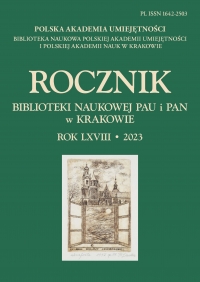MADAME DE SÉVIGNÉ I KRÓL JAN III SOBIESKI – MISTRZYNI I MISTRZ EPISTOLOGRAFII FRANCUSKIEJ I POLSKIEJ XVII W.
MADAME DE SÉVIGNÉ AND KING JOHN III SOBIESKI – THE MASTERS OF 17TH CENTURY FRENCH AND POLISH EPISTOLOGRAPHY
Author(s): Karolina TargoszSubject(s): Political history, Social history, 17th Century
Published by: Wydawnictwo Uniwersytetu Jagiellońskiego
Keywords: Marie de Rabutin-Chantal; John III Sobieski; letters; epistolography;
Summary/Abstract: Marie de Rabutin-Chantal, marchionesse de Sévigné (1626–1696) and John Sobieski (1629–1696) lived during almost the same period of time. The marchioness was three years older, they died in the same year. Lady de Sévigné became a famous epistologra- pher already during her life and shortly after she died. Sobieski’s letters got published only in the 19th c. and their literary value was underlined for the first time by a renown translator of French literature, Tadeusz Boy-Żeleński, who compared the king’s letters with those of madame de Sévigné.What the marchioness’s and the king’s letters have in common is that these were all private letters to their closest and beloved ones -marchioness’s to her daughter, lady de Grignan and Sobieski’s to his wife, Maria Kazimiera d’Arquien. Due to the distance and longing, a uniquely inspiring epistolography was created. There are of course a lot of differences between their letters, however a number of common threads may be noticed. Many times did lady de Sévigné and Sobieski express a strong belief that their feelings towards the addressees are rare and extremely strong. Similarly, they considered them to possess exceptional traits, not only physical beauty but also outstanding spiritual and mental qualities.In their letters they often articulated their concern about health issues, emphasising that their own physical state depends very much on the condition of their beloved ones. In- spired by Molier’s comedies they knew very well from books and theatres, they would also refer critically to doctors’ opinions.The marchioness was also delighted with her daughter’s knowledge of medical issues and her interest in the philosophy of Descartes, describing it as “cartesienne” and call- ing the philosopher her spiritual father. Although Sobieski’s letters do not contain any philosophical reflection, he is known to be familiar with Cartesianism and to have kept the works of Descartes in his library.What is characteristic for both collections of letters and also unique for this period, is a close and warm relation with children’s world – marchioness’s grandchildren and So- bieski’s children. The grandmother and father used to take a lot of interest in their health, cared about their illnesses, gave advice on intellectual development.In the marchioness’s and the king’s letters some pre-romantic elements are also present which are visible in their attitude towards the nature – e.g. Lady de Sévigné mentioning her night walks under the moonlight and Sobieski contemplating the sunset.
Journal: Rocznik Biblioteki Naukowej PAU i PAN
- Issue Year: 2023
- Issue No: 68
- Page Range: 71-97
- Page Count: 17
- Language: Polish

